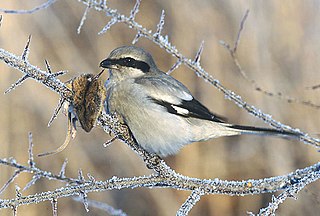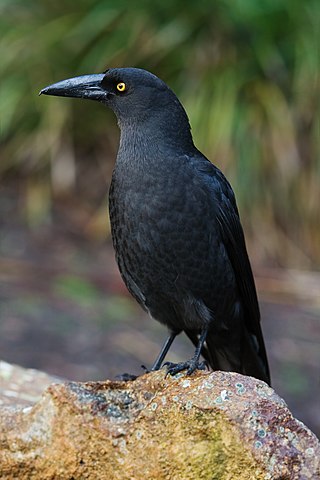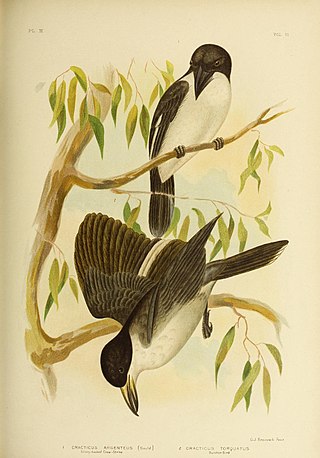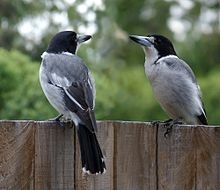
Shrikes are passerine birds of the family Laniidae. The family is composed of 34 species in two genera.

The Australian magpie is a black and white passerine bird native to Australia and southern New Guinea, and introduced to New Zealand. Although once considered to be three separate species, it is now considered to be one, with nine recognised subspecies. A member of the Artamidae, the Australian magpie is placed in its own genus Gymnorhina and is most closely related to the black butcherbird. It is not closely related to the European magpie, which is a corvid.

The great grey shrike is a large and predatory songbird species in the shrike family (Laniidae). It forms a superspecies with its parapatric southern relatives, the Iberian grey shrike, the Chinese grey shrike and the American loggerhead shrike. Males and females are similar in plumage, pearly grey above with a black eye-mask and white underparts.

The lesser grey shrike is a member of the shrike family Laniidae. It breeds in South and Central Europe and western Asia in the summer and migrates to winter quarters in southern Africa in the early autumn, returning in spring. It is a scarce vagrant to western Europe, including Great Britain, usually as a spring or autumn erratic.

Currawongs are three species of medium-sized passerine birds belonging to the genus Strepera in the family Artamidae native to Australia. These are the grey currawong, pied currawong, and black currawong. The common name comes from the call of the familiar pied currawong of eastern Australia and is onomatopoeic. They were formerly known as crow-shrikes or bell-magpies. Despite their resemblance to crows and ravens, they are only distantly related to the corvidae, instead belonging to an Afro-Asian radiation of birds of superfamily Malaconotoidea.

The black currawong, also known locally as the black jay, is a large passerine bird endemic to Tasmania and the nearby islands within the Bass Strait. One of three currawong species in the genus Strepera, it is closely related to the butcherbirds and Australian magpie within the family Artamidae. It is a large crow-like bird, around 50 cm (20 in) long on average, with yellow irises, a heavy bill, and black plumage with white wing patches. The male and female are similar in appearance. Three subspecies are recognised, one of which, Strepera fuliginosa colei of King Island, is vulnerable to extinction.

The bushshrikes are smallish passerine birds. They were formerly classed with the true shrikes in the family Laniidae, but are now considered sufficiently distinctive to be separated from that group as the family Malaconotidae, a name that alludes to their fluffy back and rump feathers.

The pied butcherbird is a songbird native to Australia. Described by John Gould in 1837, it is a black and white bird 28 to 32 cm long with a long hooked bill. Its head and throat are black, making a distinctive hood; the mantle and much of the tail and wings are also black. The neck, underparts and outer wing feathers are white. The juvenile and immature birds are predominantly brown and white. As they mature their brown feathers are replaced by black feathers. There are two recognised subspecies of pied butcherbird.

The grey butcherbird is a widely distributed species endemic to Australia. It occurs in a range of different habitats including arid, semi-arid and temperate zones. It is found across southern Australia, but is absent from the deserts of central Australia and the monsoon tropics of northern Australia. It has a characteristic rollicking birdsong. It appears to be adapting well to city living, and can be encountered in the suburbs of many Australian cities including Brisbane, Melbourne, Perth and Sydney. The grey butcherbird preys on small vertebrates including other birds.
Butcherbirds are magpie-like birds native to Australasia.

The tiger shrike or thick-billed shrike is a small passerine bird which belongs to the genus Lanius in the shrike family, Laniidae. It is found in wooded habitats across eastern Asia. It is a shy, often solitary bird which is less conspicuous than most other shrikes. Like other shrikes it is predatory, feeding on small animals. Its nest is built in a tree and three to six eggs are laid.

Cracticus is a genus of butcherbirds native to Australasia. They are large songbirds, being between 30 and 40 cm (12–16 in) in length. Their colour ranges from black-and-white to mostly black with added grey plumage, depending on the species. They have a large, straight bill with a distinctive hook at the end which is used to skewer prey. They have high-pitched complex songs, which are used to defend their essentially year-round group territories: unlike birds of extratropical Eurasia and the Americas, both sexes sing prolifically.

The red-capped robin is a small passerine bird native to Australia. Found in drier regions across much of the continent, it inhabits scrub and open woodland. Like many brightly coloured robins of the family Petroicidae, it is sexually dimorphic. Measuring 10.5–12.5 cm (4.1–4.9 in) in length, the robin has a small, thin, black bill, and dark brown eyes and legs. The male has a distinctive red cap and red breast, black upperparts, and a black tail with white tips. The underparts and shoulders are white. The female is an undistinguished grey-brown. This species uses a variety of songs, and males generally sing to advertise territories and attract females. Birds are encountered in pairs or small groups, but the social behaviour has been little studied.

The hooded butcherbird is a species of passerine bird in the family Artamidae. It is found in New Guinea. Its natural habitat is subtropical or tropical moist lowland forest.

The black-backed butcherbird is a species of bird in the family Artamidae. It is found in southern New Guinea and Cape York Peninsula.

The black butcherbird is a species of butcherbird in the family Artamidae. It is found in Australia, Indonesia, and Papua New Guinea. Its natural habitats are subtropical or tropical dry forest, subtropical or tropical moist lowland forest, and subtropical or tropical mangrove forest.

The silver-backed butcherbird is a small, shrike-like bird. It is almost identical to the grey butcherbird of which it considered by some authorities to be a subspecies, C. torquatus argenteus.

Artamidae is a family of passerine birds found in Australia, the Indo-Pacific region, and Southern Asia. It includes 24 extant species in six genera and three subfamilies: Peltopsinae, Artaminae and Cracticinae. Artamids used to be monotypic, containing only the woodswallows, but it was expanded to include the family Cracticidae in 1994. Some authors, however, still treat the two as separate families. Some species in this family are known for their beautiful song. Their feeding habits vary from nectar sucking (woodswallows) to predation on small birds.

Kurrartapu johnnguyeni is an extinct species of bird in the Australian magpie and butcherbird family. It was described from Early Miocene material found at Riversleigh in north-western Queensland, Australia. It is the first Tertiary record of a cracticid from Australia. The size of the fossil material indicates that it was similar in size to the living black butcherbird. The generic name is a Kalkatungu language term for the Australian magpie. The specific epithet honours John Nguyen, the father of the senior describer.



















